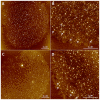Expanded repertoire of kinetoplast associated proteins and unique mitochondrial DNA arrangement of symbiont-bearing trypanosomatids
- PMID: 29131838
- PMCID: PMC5683618
- DOI: 10.1371/journal.pone.0187516
Expanded repertoire of kinetoplast associated proteins and unique mitochondrial DNA arrangement of symbiont-bearing trypanosomatids
Abstract
In trypanosomatids, the kinetoplast is the portion of the single mitochondrion that is connected to the basal body and contains the kDNA, a network composed by circular and interlocked DNA. The kDNA packing is conducted by Kinetoplast Associated Proteins (KAPs), which are similar to eukaryotic histone H1. In symbiont-harboring trypanosomatids (SHTs) such as Angomonas deanei and Strigomonas culicis, a ß-proteobacterium co-evolves with the host in a mutualistic relationship. The prokaryote confers nutritional benefits to the host and affects its cell structure. Atomic force microscopy showed that the topology of isolated kDNA networks is quite similar in the two SHT species. Ultrastructural analysis using high-resolution microscopy techniques revealed that the DNA fibrils are more compact in the kinetoplast region that faces the basal body and that the presence of the symbiotic bacterium does not interfere with kDNA topology. However, RT-PCR data revealed differences in the expression of KAPs in wild-type protozoa as compared to aposymbiotic cells. Immunolocalization showed that different KAPs present distinct distributions that are coincident in symbiont-bearing and in symbiont-free cells. Although KAP4 and KAP7 are shared by all trypanosomatid species, the expanded repertoire of KAPs in SHTs can be used as phylogenetic markers to distinguish different genera.
Conflict of interest statement
Figures





Similar articles
-
From mitochondrial DNA arrangement to repair: a kinetoplast-associated protein with different roles in two trypanosomatid species.Parasit Vectors. 2025 Aug 28;18(1):366. doi: 10.1186/s13071-025-06985-8. Parasit Vectors. 2025. PMID: 40877949 Free PMC article.
-
The Kinetoplast of Trypanosomatids: From Early Studies of Electron Microscopy to Recent Advances in Atomic Force Microscopy.Scanning. 2018 Jun 19;2018:9603051. doi: 10.1155/2018/9603051. eCollection 2018. Scanning. 2018. PMID: 30018700 Free PMC article. Review.
-
Importance of Angomonas deanei KAP4 for kDNA arrangement, cell division and maintenance of the host-bacterium relationship.Sci Rep. 2021 Apr 28;11(1):9210. doi: 10.1038/s41598-021-88685-8. Sci Rep. 2021. PMID: 33911164 Free PMC article.
-
Phylogenetic validation of the genera Angomonas and Strigomonas of trypanosomatids harboring bacterial endosymbionts with the description of new species of trypanosomatids and of proteobacterial symbionts.Protist. 2011 Jul;162(3):503-24. doi: 10.1016/j.protis.2011.01.001. Epub 2011 Mar 21. Protist. 2011. PMID: 21420905
-
The structure and replication of kinetoplast DNA.Annu Rev Microbiol. 1995;49:117-43. doi: 10.1146/annurev.mi.49.100195.001001. Annu Rev Microbiol. 1995. PMID: 8561456 Review.
Cited by
-
A dataset of proteins associated with Trypanosoma cruzi LYT1 mRNAs.Data Brief. 2022 Feb 15;41:107953. doi: 10.1016/j.dib.2022.107953. eCollection 2022 Apr. Data Brief. 2022. PMID: 35242934 Free PMC article.
-
From mitochondrial DNA arrangement to repair: a kinetoplast-associated protein with different roles in two trypanosomatid species.Parasit Vectors. 2025 Aug 28;18(1):366. doi: 10.1186/s13071-025-06985-8. Parasit Vectors. 2025. PMID: 40877949 Free PMC article.
-
The Kinetoplast of Trypanosomatids: From Early Studies of Electron Microscopy to Recent Advances in Atomic Force Microscopy.Scanning. 2018 Jun 19;2018:9603051. doi: 10.1155/2018/9603051. eCollection 2018. Scanning. 2018. PMID: 30018700 Free PMC article. Review.
-
Factors Associated with HIV and Vulnerability Contexts for Women in Brazil.Arch Sex Behav. 2021 Oct;50(7):3247-3256. doi: 10.1007/s10508-021-01960-7. Epub 2021 Apr 16. Arch Sex Behav. 2021. PMID: 33864176
-
Direct monitoring of the stepwise condensation of kinetoplast DNA networks.Sci Rep. 2021 Jan 15;11(1):1501. doi: 10.1038/s41598-021-81045-6. Sci Rep. 2021. PMID: 33452335 Free PMC article.
References
-
- Schmid MB. More than just "histone-like" proteins. Cell. 1990; 63: 451–453. - PubMed
-
- Luijsterburg MS, Noom MC, Wuite GJ, Dame RT. The architectural role of nucleoid-associated proteins in the organization of bacterial chromatin: a molecular perspective. J Struct Biol. 2006; 156: 262–272. doi: 10.1016/j.jsb.2006.05.006 - DOI - PubMed
-
- Kucej M, Butow RA. Evolutionary tinkering with mitochondrial nucleoids. Trends Cell Biol. 2007; 17:586–592. doi: 10.1016/j.tcb.2007.08.007 - DOI - PubMed
-
- Timmis J.N., Ayliffe MA, Huang CY, Martin W. Endosymbiotic gene transfer: organelle genomes forge eukaryotic chromosomes. Nature reviews: Genetics. 2004; 5: 123–135. doi: 10.1038/nrg1271 - DOI - PubMed
-
- Holt IJ, He J, Mao CC, Boyd-Kirkup JD, Martinsson P, Sembongi H, et al. Mammalian mitochondrial nucleoids: organizing an independently minded genome. Mitochondrion. 2007; 7: 311–321. doi: 10.1016/j.mito.2007.06.004 - DOI - PubMed
MeSH terms
Substances
LinkOut - more resources
Full Text Sources
Other Literature Sources

